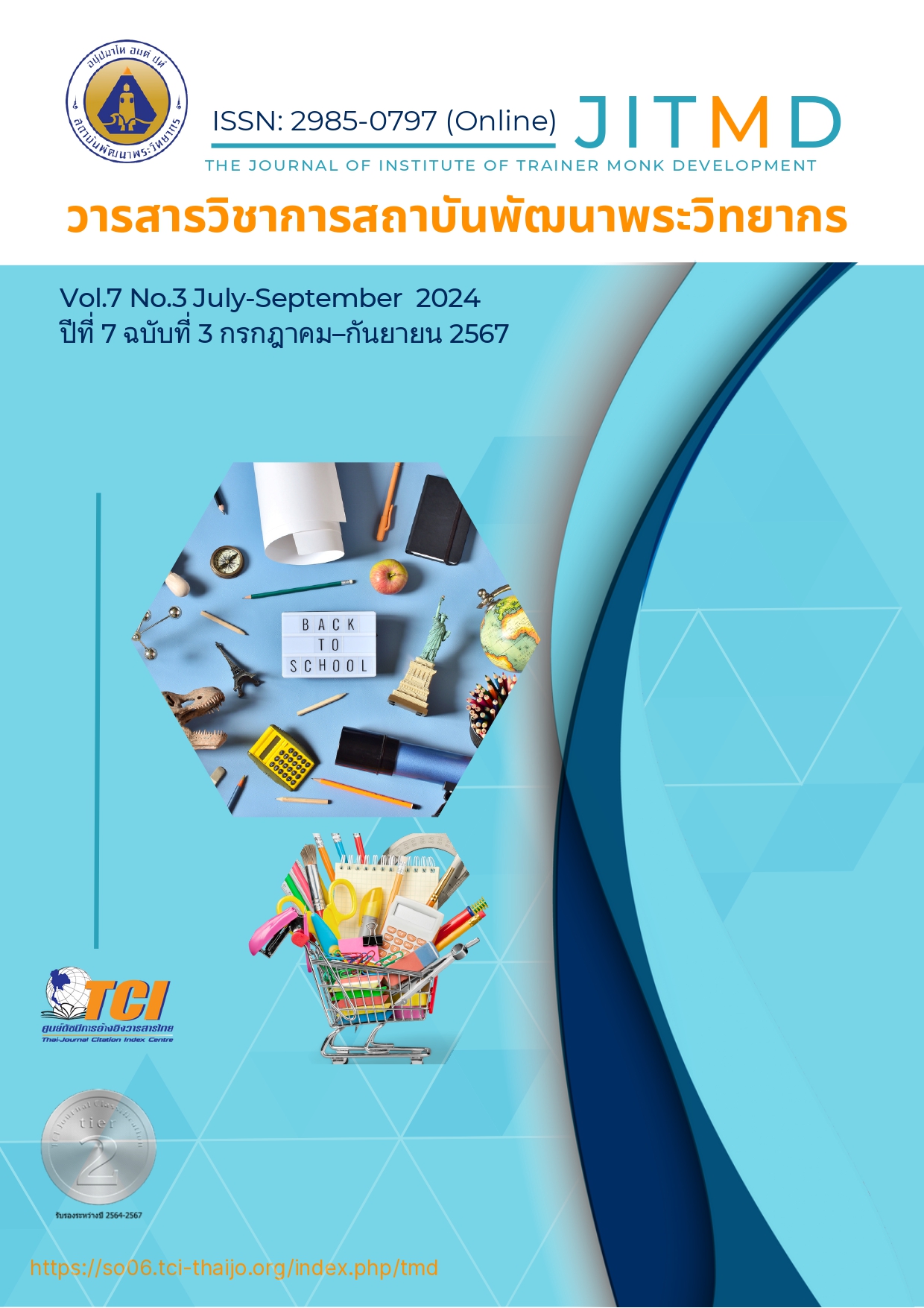Factors of AdministratioFactors of Administration That Effect Learning Organization of Schools Under Secondary Educational Service Area Office, Nonthaburi n That Effect Learning Organization of Schools under Secondary Educational Service Area Office, Nonthaburi
Main Article Content
Abstract
The objectives of this thesis are as follows: 1) to study the administrative factors of educational institutions under the Nonthaburi Secondary Educational Service Area Office 2) To study the learning organization of educational institutions under the Secondary Educational Service Area Office 3) To study administrative factors that affect the learning organization of educational institutions under the Nonthaburi Secondary Education Service Area Office. The samples used in this study were: The school is affiliated with the Nonthaburi Secondary Education Service Area Office. The research tool is a questionnaire to analyze data. Statistics used in data analysis include frequency, percentage, average (𝑥̅) Standard Deviation (S.D.) Hypothesis Test Stepwise Multiple Regression Analysis. The results of research were found that 1) The administrative factors of educational institutions under the Nonthaburi Secondary Education Service Area Office as a whole are at a large level. When considered on a case-by-side basis, it was found to be on a high level in all aspects, in descending order of average. Management, Material, Money, and Human resources or personnel, respectively 2) Being a learning organization of educational institutions under the Nonthaburi Secondary Education Service Area Office as a whole is at a high level. When considered on a case-by-side basis, it was found that it was at the highest level in 3 areas and on the upper 2 aspects, in descending order of average. These include increasing the ability to use technology, knowledge management, power and capacity building, organizational transformation, and learning dynamics respectively 3) Administrative factors affecting the organization of learning institutions under the Nonthaburi Secondary Education Service Area Office By sorting the prediction coefficients by importance. As follows: management, finance or budget, and management factors. It affects the learning organization of educational institutions under the Nonthaburi Secondary Education Service Area Office. Statistically significant at the .001 level, the prediction efficiency R Square) was 0.512, and the standard error in prediction (Standard Error) was 0.420.
Article Details

This work is licensed under a Creative Commons Attribution-NonCommercial-NoDerivatives 4.0 International License.
บทความที่ได้รับการตีพิมพ์เป็นลิขสิทธิ์ของวารสารวิชาการสถาบันพัฒนาพระวิทยากร
ข้อความที่ปรากฎอยู่ในบทความที่ได้รับการตีพิมพ์ในวารสาร ถือเป็นความรับผิดชอบของผู้เขียนบทความ และข้อคิดเห็นนั้นไม่ถือว่าเป็นทัศนะและความรับผิดชอบของกองบรรณาธิการวารสารวิชาการสถาบันพัฒนาพระวิทยากร
References
สำนักงานคณะกรรมการพัฒนาระบบราชการ. (2556). คู่มือคำอธิบายและแนวทางปฏิบัติตามพระราชกฤษฎีกาว่าด้วยหลักเกณฑ์และวิธีการบริหารกิจการบ้านเมืองที่ดี. กรุงเทพฯ: วิชั่น พับบลิชชิ่ง.
สำนักงานเขตพื้นที่การศึกษามัธยมศึกษานนทบุรี. (2564). การทำวิจัยเชิงพื้นที่เพื่อการจัดทำนโยบายการจัดการเรียนรู้วิถีใหม่ สพม. นนทบุรี: สำนักงานเขตพื้นที่การศึกษามัธยมศึกษานนทบุรี.
ทองหล่อ เดชไทย. (2553). ภาวะนำ: เพื่อการบริหารคุณภาพสู่ความเป็นเลิศ Leadership for excellent Quality management. กรุงเทพฯ: ภาควิชาบริหารงานสาธารณสุข คณะสาธารณสุขศาสตร์ มหาวิทยาลัยมหิดล.
บุญชม ศรีสะอาด. (2545). การวิจัยเบื้องต้น. (พิมพ์ครั้งที่ 7). กรุงเทพฯ: สุวีริยาสาส์น.
บุญชม ศรีสะอาด. (2556). การวิจัยเบื้องต้น. (พิมพ์ครั้งที่ 9). กรุงเทพฯ: สุวีริยาสาส์น.
สำนักงานคณะกรรมการพัฒนาระบบราชการ. (2556). แผนยุทธศาสตร์การพัฒนาระบบราชการไทย (พ.ศ. 2556–พ.ศ. 2561). กรุงเทพฯ: สำนักนายกรัฐมนตรี.
ประจักร บัวผัน. (2552). หลักการบริหารสาธารณสุข. ขอนแก่น: โรงพิมพ์หาวิทยาลัยขอนแก่น.
พัทธิพงศ์ พลอาจ และคณะ. (2557). กลยุทธ์การพัฒนาโรงเรียนขยายโอกาสทางการศึกษาในจังหวัดกำแพงเพชรให้เป็นองค์การแห่งการเรียนรู้. วารสารศึกษาศาสตร์มหาวิทยาลัยนเรศวร, 16(1): 32-38.
เมรินทกาล พัฒนทรัพย์พิศาล. (2561). ปัจจัยการบริหารที่ส่งผลต่อประสิทธิผลของโรงเรียนสังกัดสำนักงานเขตพื้นที่การศึกษามัธยมศึกษา เขต 23. วิทยานิพนธ์ครุศาสตรมหาบัณฑิต สกลนคร. มหาวิทยาลัยราชภัฏสกลนคร.
วริศรา อรุณกิตติพร. (2561). ปัจจัยการบริหารของผู้บริหารสถานศึกษาที่ส่งผลต่อประสิทธิผลของสถานศึกษาสังกัดสำนักงานเขตพื้นที่การศึกษาประถมศึกษา ตราด. วิทยานิพนธ์การศึกษามหาบัณฑิต. บัณฑิตวิทยาลัย: มหาวิทยาลัยบูรพา.
วิมาลย์ ลีทอง. (2563). ปัจจัยการบริหารที่ส่งผลต่อประสิทธิผลโรงเรียน สังกัดสำนักงานคณะกรรมการการศึกษาขั้นพื้นฐาน ในจังหวัดสกลนคร. วิทยานิพนธ์ครุศาสตรมหาบัณฑิต. มหาวิทยาลัยราชภัฏสกลนคร.
Marquardt, M. (2002). Building the Learning Organization: Master the 5 Elements for Corporate Learning. California: Davies-Black Publishing.
Nonaka, I. and Takeuchi, H. (1995). The Knowledge-Creating Company. Oxford University: Press, Oxford.
Senge, Peter M. (1990). The Fifth Discipline: The Art and Practice of Learning Organization. New York: Doubleday/Currency.


